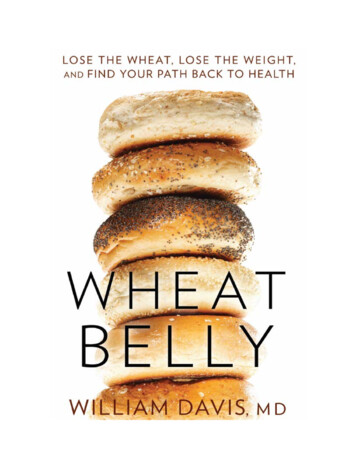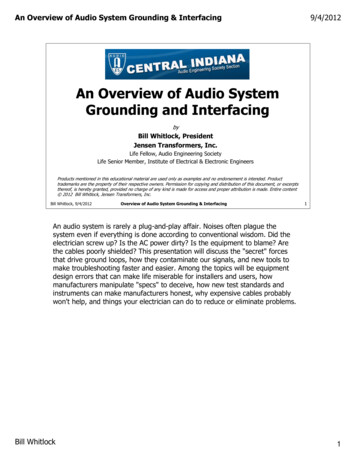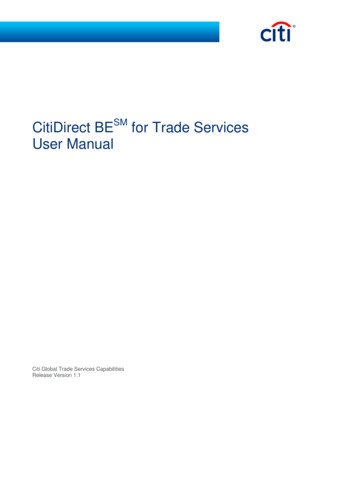
Transcription
For Dawn, Bill, Lauren, and Jacob,my companions on this wheat-free journey
CONTENTSIntroductionPART ONE WHEAT: THE UNHEALTHY WHOLE GRAINChapter 1 What Belly?Chapter 2 Not Your Grandma’s Muffins: The Creation of Modern WheatChapter 3 Wheat DeconstructedPART TWO WHEAT AND ITS HEAD-TO-TOE DESTRUCTION OF HEALTHChapter 4 Hey, Man, Wanna Buy Some Exorphins? The Addictive Properties of WheatChapter 5 Your Wheat Belly Is Showing: The Wheat/Obesity ConnectionChapter 6 Hello, Intestine. It’s Me, Wheat. Wheat and Celiac DiseaseChapter 7 Diabetes Nation: Wheat and Insulin ResistanceChapter 8 Dropping Acid: Wheat as the Great pH DisrupterChapter 9 Cataracts, Wrinkles, and Dowager’s Humps: Wheat and the Aging ProcessChapter 10 My Particles Are Bigger Than Yours: Wheat and Heart DiseaseChapter 11 It’s All in Your Head: Wheat and the BrainChapter 12 Bagel Face: Wheat’s Destructive Effect on the SkinPART THREE SAY GOODBYE TO WHEATChapter 13 Goodbye, Wheat: Create a Healthy, Delicious, Wheat-Free LifeEpilogueAppendix A Looking for Wheat in All the Wrong PlacesAppendix B Healthy Wheat Belly-Shrinking RecipesAcknowledgmentsReferencesIndex
INTRODUCTIONFLIP THROUGH YOUR parents’ or grandparents’ family albums and you’re likely to be struck byhow thin everyone looks. The women probably wore size-four dresses and the men sported 32-inchwaists. Overweight was something measured only by a few pounds; obesity rare. Overweightchildren? Almost never. Any 42-inch waists? Not here. Two-hundred-pound teenagers? Certainly not.Why were the June Cleavers of the fifties and sixties, the stay-at-home housewives as well as otherpeople of that era, so much skinnier than the modern people we see at the beach, mall, or in our ownmirrors? While women of that era typically weighed in at 110 or 115 pounds, men at 150 or 165pounds, today we carry 50, 75, even 200 pounds more.The women of that world didn’t exercise much at all. (It was considered unseemly, after all, likehaving impure thoughts at church.) How many times did you see your mom put on her jogging shoesto go out for a three-mile run? Exercise for my mother was vacuuming the stairs. Nowadays I gooutdoors on any nice day and see dozens of women jogging, riding their bicycles, power walking—things we’d virtually never see 40 or 50 years ago. And yet, we’re getting fatter and fatter every year.My wife is a triathlete and triathlon instructor, so I observe a few of these extreme exercise eventsevery year. Triathletes train intensively for months to years before a race to complete a 1- to 2½-mileopen water swim, a 56- to 112-mile bike ride, and finish with a 13- to 26-mile run. Just completing arace is a feat in itself, since the event requires up to several thousand calories and spectacularendurance. The majority of triathletes adhere to fairly healthy eating habits.Then why are a third of these dedicated men and women athletes overweight? I give them evengreater credit for having to cart around the extra thirty, forty, or fifty pounds. But, given their extremelevel of sustained activity and demanding training schedule, how can they still be overweight?If we follow conventional logic, overweight triathletes need to exercise more or eat less to loseweight. I believe that is a downright ridiculous notion. I am going to argue that the problem with thediet and health of most Americans is not fat, not sugar, not the rise of the Internet and the demise ofthe agrarian lifestyle. It’s wheat—or what we are being sold that is called “wheat.”You will see that what we are eating, cleverly disguised as a bran muffin or onion ciabatta, is notreally wheat at all but the transformed product of genetic research conducted during the latter half ofthe twentieth century. Modern wheat is no more real wheat than a chimpanzee is an approximation ofa human. While our hairy primate relatives share 99 percent of all genes found in humans, with longerarms, full body hair, and lesser capacity to win the jackpot at Jeopardy, I trust you can readily tell thedifference that that 1 percent makes. Compared to its ancestor of only forty years ago, modern wheatisn’t even that close.
I believe that the increased consumption of grains—or more accurately, the increased consumptionof this genetically altered thing called modern wheat—explains the contrast between slender,sedentary people of the fifties and overweight twenty-first-century people, triathletes included.I recognize that declaring wheat a malicious food is like declaring that Ronald Reagan was aCommunist. It may seem absurd, even unpatriotic, to demote an iconic dietary staple to the status ofpublic health hazard. But I will make the case that the world’s most popular grain is also the world’smost destructive dietary ingredient.Documented peculiar effects of wheat on humans include appetite stimulation, exposure to brainactive exorphins (the counterpart of internally derived endorphins), exaggerated blood sugar surgesthat trigger cycles of satiety alternating with heightened appetite, the process of glycation thatunderlies disease and aging, inflammatory and pH effects that erode cartilage and damage bone, andactivation of disordered immune responses. A complex range of diseases results from consumption ofwheat, from celiac disease—the devastating intestinal disease that develops from exposure to wheatgluten—to an assortment of neurological disorders, diabetes, heart disease, arthritis, curious rashes,and the paralyzing delusions of schizophrenia.If this thing called wheat is such a problem, then removing it should yield outsize and unexpectedbenefits. Indeed, that is the case. As a cardiologist who sees and treats thousands of patients at risk forheart disease, diabetes, and the myriad destructive effects of obesity, I have personally observedprotuberant, flop-over-the-belt belly fat vanish when my patients eliminated wheat from their diets,with typical weight loss totaling 20, 30, or 50 pounds just within the first few months. Rapid andeffortless weight loss is usually followed by health benefits that continue to amaze me even today afterhaving witnessed this phenomenon thousands of times.I’ve seen dramatic turnarounds in health, such as the thirty-eight-year-old woman with ulcerativecolitis facing colon removal who was cured with wheat elimination—colon intact. Or the twenty-sixyear-old man, incapacitated and barely able to walk because of joint pain, who experienced completerelief and walked and ran freely again after taking wheat off the menu.Extraordinary as these results may sound, there is ample scientific research to implicate wheat asthe root cause of these conditions—and to indicate that removal of wheat can reduce or relievesymptoms entirely. You will see that we have unwittingly traded convenience, abundance, and lowcost for health with wheat bellies, bulging thighs, and double chins to prove it. Many of the argumentsI make in the chapters that follow have been proven in scientific studies that are available for one andall to review. Incredibly, many of the lessons I’ve learned were demonstrated in clinical studiesdecades ago, but somehow never percolated to the surface of medical or public consciousness. I’vesimply put two and two together to come up with some conclusions that you may find startling.
IT’S NOT YOUR FAULTIn the movie Good Will Hunting, Matt Damon’s character, possessing uncommon genius butharboring demons of past abuse, breaks down in sobs when psychologist Sean Maguire (RobinWilliams) repeats “It’s not your fault” over and over again.Likewise, too many of us, stricken with an unsightly wheat belly, blame ourselves: too manycalories, too little exercise, too little restraint. But it’s more accurate to say that the advice we’ve beengiven to eat more “healthy whole grains” has deprived us of control over appetites and impulses,making us fat and unhealthy despite our best efforts and good intentions.I liken the widely accepted advice to eat healthy whole grains to telling an alcoholic that, if a drinkor two won’t hurt, nine or ten may be even better. Taking this advice has disastrous repercussions onhealth.It’s not your fault.If you find yourself carrying around a protuberant, uncomfortable wheat belly; unsuccessfullytrying to squeeze into last year’s jeans; reassuring your doctor that, no, you haven’t been eating badly,but you’re still overweight and prediabetic with high blood pressure and cholesterol; or desperatelytrying to conceal a pair of humiliating man breasts, consider saying goodbye to wheat.Eliminate the wheat, eliminate the problem.What have you got to lose except your wheat belly, your man breasts, or your bagel butt?
PART ONEWHEAT:THE UNHEALTHY WHOLE GRAINCHAPTER 1WHAT BELLY?The scientific physician welcomes the establishment of a standard loaf of bread madeaccording to the best scientific evidence. Such a product can be included in diets both forthe sick and for the well with a clear understanding of the effect that it may have on digestionand growth.Morris Fishbein, MD,editor, Journal of the American Medical Association, 1932IN CENTURIES PAST, a prominent belly was the domain of the privileged, a mark of wealth andsuccess, a symbol of not having to clean your own stables or plow your own field. In this century, youdon’t have to plow your own field. Today, obesity has been democratized: Everybody can have a bigbelly. Your dad called his rudimentary mid-twentieth-century equivalent a beer belly. But what aresoccer moms, kids, and half of your friends and neighbors who don’t drink beer doing with a beerbelly?I call it wheat belly, though I could have just as easily called this condition pretzel brain or bagelbowel or biscuit face since there’s not an organ system unaffected by wheat. But wheat’s impact onthe waistline is its most visible and defining characteristic, an outward expression of the grotesquedistortions humans experience with consumption of this grain.A wheat belly represents the accumulation of fat that results from years of consuming foods thattrigger insulin, the hormone of fat storage. While some people store fat in their buttocks and thighs,most people collect ungainly fat around the middle. This “central” or “visceral” fat is unique: Unlikefat in other body areas, it provokes inflammatory phenomena, distorts insulin responses, and issuesabnormal metabolic signals to the rest of the body. In the unwitting wheat-bellied male, visceral fatalso produces estrogen, creating “man breasts.”The consequences of wheat consumption, however, are not just manifested on the body’s surface;wheat can also reach deep down into virtually every organ of the body, from the intestines, liver,heart, and thyroid gland all the way up to the brain. In fact, there’s hardly an organ that is not affectedby wheat in some potentially damaging way.
PANTING AND SWEATING IN THE HEARTLANDI practice preventive cardiology in Milwaukee. Like many other midwestern cities, Milwaukee is agood place to live and raise a family. City services work pretty well, the libraries are first-rate, mykids go to quality public schools, and the population is just large enough to enjoy big-city culture,such as an excellent symphony and art museum. The people living here are a fairly friendly bunch.But they’re fat.I don’t mean a little bit fat. I mean really, really fat. I mean panting-and-sweating-after-one-flightof-stairs fat. I mean 240-pound 18-year-old women, SUVs tipped sharply to the driver’s side, doublewide wheelchairs, hospital equipment unable to accommodate patients who tip the scales at 350pounds or more. (Not only can’t they fit into the CT scanner or other imaging device, you wouldn’t beable to see anything even if they could. It’s like trying to determine whether the image in the murkyocean water is a flounder or a shark.)Once upon a time, an individual weighing 250 pounds or more was a rarity; today it’s a commonsight among the men and women walking the mall, as humdrum as selling jeans at the Gap. Retiredpeople are overweight or obese, as are middle-aged adults, young adults, teenagers, even children.White-collar workers are fat, blue-collar workers are fat. The sedentary are fat and so are athletes.White people are fat, black people are fat, Hispanics are fat, Asians are fat. Carnivores are fat,vegetarians are fat. Americans are plagued by obesity on a scale never before seen in the humanexperience. No demographic has escaped the weight gain crisis.Ask the USDA or the Surgeon General’s office and they will tell you that Americans are fatbecause they drink too many soft drinks, eat too many potato chips, drink too much beer, and don’texercise enough. And those things may indeed be true. But that’s hardly the whole story.Many overweight people, in fact, are quite health conscious. Ask anyone tipping the scales over250 pounds: What do you think happened to allow such incredible weight gain? You may be surprisedat how many do not say “I drink Big Gulps, eat Pop Tarts, and watch TV all day.” Most will saysomething like “I don’t get it. I exercise five days a week. I’ve cut my fat and increased my healthywhole grains. Yet I can’t seem to stop gaining weight!”HOW DID WE GET HERE?The national trend to reduce fat and cholesterol intake and increase carbohydrate calories has created apeculiar situation in which products made from wheat have not just increased their presence in ourdiets; they have come to dominate our diets. For most Americans, every single meal and snackcontains foods made with wheat flour. It might be the main course, it might be the side dish, it mightbe the dessert—and it’s probably all of them.Wheat has become the national icon of health: “Eat more healthy whole grains,” we’re told, andthe food industry happily jumped on board, creating “heart healthy” versions of all our favorite wheatproducts chock-full of whole grains.
The sad truth is that the proliferation of wheat products in the American diet parallels theexpansion of our waists. Advice to cut fat and cholesterol intake and replace the calories with wholegrains that was issued by the National Heart, Lung, and Blood Institute through its NationalCholesterol Education Program in 1985 coincides precisely with the start of a sharp upward climb inbody weight for men and women. Ironically, 1985 also marks the year when the Centers for DiseaseControl and Prevention (CDC) began tracking body weight statistics, tidily documenting the explosionin obesity and diabetes that began that very year.Of all the grains in the human diet, why only pick on wheat? Because wheat, by a considerablemargin, is the dominant source of gluten protein in the human diet. Unless they’re Euell Gibbons,most people don’t eat much rye, barley, spelt, triticale, bulgur, kamut, or other less common glutensources; wheat consumption overshadows consumption of other gluten-containing grains by more thana hundred to one. Wheat also has unique attributes those other grains do not, attributes that make itespecially destructive to our health, which I will cover in later chapters. But I focus on wheat because,in the vast majority of American diets, gluten exposure can be used interchangeably with wheatexposure. For that reason, I often use wheat to signify all gluten-containing grains.The health impact of Triticum aestivum, common bread wheat, and its genetic brethren ranges farand wide, with curious effects from mouth to anus, brain to pancreas, Appalachian housewife to WallStreet arbitrageur.If it sounds crazy, bear with me. I make these claims with a clear, wheat-free conscience.NUTRI-GROANLike most children of my generation, born in the middle of the twentieth century and reared onWonder Bread and Devil Dogs, I have a long and close personal relationship with wheat. My sistersand I were veritable connoisseurs of breakfast cereal, making our own individual blends of Trix,Lucky Charms, and Froot Loops and eagerly drinking the sweet, pastel-hued milk that remained at thebottom of the bowl. The Great American Processed Food Experience didn’t end at breakfast, ofcourse. For school lunch my mom usually packed peanut butter or bologna sandwiches, the prelude tocellophane-wrapped Ho Hos and Scooter Pies. Sometimes she would throw in a few Oreos or ViennaFingers, too. For supper, we loved the TV dinners that came packaged in their own foil plates,allowing us to consume our battered chicken, corn muffin, and apple brown betty while watching GetSmart.My first year of college, armed with an all-you-can-eat dining room ticket, I gorged on waffles andpancakes for breakfast, fettuc-cine Alfredo for lunch, pasta with Italian bread for dinner. Poppy seedmuffin or angel food cake for dessert? You bet! Not only did I gain a hefty spare tire around themiddle at age nineteen, I felt exhausted all the time. For the next twenty years, I battled this effect,drinking gallons of coffee, struggling to shake off the pervasive stupor that persisted no matter howmany hours I slept each night.Yet none of this really registered until I caught sight of a photo my wife snapped of me while onvacation with our kids, then ages ten, eight, and four, on Marco Island, Florida. It was 1999.
In the picture, I was fast asleep on the sand, my flabby abdomen splayed to either side, my secondchin resting on my crossed flabby arms.That’s when it really hit me: I didn’t just have a few extra pounds to lose, I had a good thirtypounds of accumulated weight around my middle. What must my patients be thinking when Icounseled them on diet? I was no better than the doctors of the sixties puffing on Marlboros whileadvising their patients to live healthier lives.Why did I have those extra pounds under my belt? After all, I jogged three to five miles every day,ate a sensible, balanced diet that didn’t include excessive quantities of meats or fats, avoided junkfoods and snacks, and instead concentrated on getting plenty of healthy whole grains. What was goingon here?Sure, I had my suspicions. I couldn’t help but notice that on the days when I’d eat toast, waffles, orbagels for breakfast, I’d stumble through several hours of sleepiness and lethargy. But eat a three-eggomelet with cheese, feel fine. Some basic laboratory work, though, really stopped me in my tracks.Triglycerides: 350 mg/dl; HDL (“good”) cholesterol: 27 mg/dl. And I was diabetic, with a fastingblood sugar of 161 mg/dl. Jogging nearly every day but I was overweight and diabetic? Somethinghad to be fundamentally wrong with my diet. Of all the changes I had made in my diet in the name ofhealth, boosting my intake of healthy whole grains had been the most significant. Could it be that thegrains were actually making me fatter?That moment of flabby realization began the start of a journey, following the trail of crumbs backfrom being overweight and all the health problems that came with it. But it was when I observed evengreater effects on a larger scale beyond my own personal experience that I became convinced thatthere really was something interesting going on.LESSONS FROM A WHEAT-FREE EXPERIMENTAn interesting fact: Whole wheat bread (glycemic index 72) increases blood sugar as much as or morethan table sugar, or sucrose (glycemic index 59). (Glucose increases blood sugar to 100, hence aglycemic index of 100. The extent to which a particular food increases blood sugar relative to glucosedetermines that food’s glycemic index.) So when I was devising a strategy to help my overweight,diabetes-prone patients reduce blood sugar most efficiently, it made sense to me that the quickest andsimplest way to get results would be to eliminate the foods that caused their blood sugar to rise mostprofoundly: in other words, not sugar, but wheat. I provided a simple handout detailing how to replacewheat-based foods with other low-glycemic whole foods to create a healthy diet.After three months, my patients returned to have more blood work done. As I had anticipated, withonly rare exceptions, blood sugar (glucose) had indeed often dropped from diabetic range (126 mg/dlor greater) to normal. Yes, diabetics became nondiabetics. That’s right: Diabetes in many cases can becured—not simply managed—by removal of carbohydrates, especially wheat, from the diet. Many ofmy patients had also lost twenty, thirty, even forty pounds.But it’s what I didn’t expect that astounded me.
They reported that symptoms of acid reflux disappeared and the cyclic cramping and diarrhea ofirritable bowel syndrome were gone. Their energy improved, they had greater focus, sleep was deeper.Rashes disappeared, even rashes that had been present for many years. Their rheumatoid arthritis painimproved or disappeared, enabling them to cut back, even eliminate, the nasty medications used totreat it. Asthma symptoms improved or resolved completely, allowing many to throw away theirinhalers. Athletes reported more consistent performance.Thinner. More energetic. Clearer thinking. Better bowel, joint, and lung health. Time and timeagain. Surely these results were reason enough to forgo wheat.What convinced me further were the many instances in which people removed wheat, thenpermitted themselves a wheat indulgence: a couple of pretzels, a canapé at a cocktail party. Withinminutes, many would experience diarrhea, joint swelling and pain, or wheezing. On again, off again,the phenomenon would repeat itself.What started out as a simple experiment in reducing blood sugars exploded into an insight intomultiple health conditions and weight loss that continues to amaze me even today.A RADICAL WHEAT-ECTOMYFor many, the idea of removing wheat from the diet is, at least psychologically, as painful as thethought of having a root canal without anesthesia. For some, the process can indeed haveuncomfortable side effects akin to withdrawal from cigarettes or alcohol. But this procedure must beperformed to permit the patient to recover.Wheat Belly explores the proposition that the health problems of Americans, from fatigue toarthritis to gastrointestinal distress to obesity, originate with the innocent-looking bran muffin orcinnamon raisin bagel you down with your coffee every morning.The good news: There is a cure for this condition called wheat belly—or, if you prefer, pretzelbrain, bagel bowel, or biscuit face.The bottom line: Elimination of this food, part of human culture for more centuries than LarryKing was on the air, will make you sleeker, smarter, faster, and happier. Weight loss, in particular, canproceed at a pace you didn’t think possible. And you can selectively lose the most visible, insulinopposing, diabetes-creating, inflammation-producing, embarrassment-causing fat: belly fat. It is aprocess accomplished with virtually no hunger or deprivation, with a wide spectrum of health benefits.So why eliminate wheat rather than, say, sugar, or all grains in general? The next chapter willexplain why wheat is unique among modern grains in its ability to convert quickly to blood sugar. Inaddition, it has a poorly understood and understudied genetic makeup and addictive properties thatactually cause us to overeat even more; has been linked to literally dozens of debilitating ailmentsbeyond those associated with overweight; and has infiltrated almost every aspect of our diet. Sure,cutting out refined sugar is probably a good idea, as it provides little or no nutritional benefit and willalso impact your blood sugar in a negative way. But for the most bang for your buck, eliminatingwheat is the easiest and most effective step you can take to safeguard your health and trim yourwaistline.
CHAPTER 2NOT YOUR GRANDMA’S MUFFINS: THE CREATIONOF MODERN WHEATHe is as good as good bread.Miguel de Cervantes,Don QuixoteWHEAT, MORE THAN any other foodstuff (including sugar, fat, and salt), is woven into the fabricof the American food experience, a trend that began even before Ozzie met Harriet. It has becomesuch a ubiquitous part of the American diet in so many ways that it seems essential to our lifestyle.What would a plate of eggs be without toast, lunch without sandwiches, beer without pretzels, picnicswithout hot dog buns, dip without crackers, hummus without pita, lox without bagels, apple piewithout the crust?IF IT’S TUESDAY, IT MUST BE WHEATI once measured the length of the bread aisle at my local supermarket: sixty-eight feet.That’s sixty-eight feet of white bread, whole wheat bread, multigrain bread, seven-grain bread, ryebread, pumpernickel bread, sourdough bread, Italian bread, French bread, bread sticks, white bagels,raisin bagels, cheese bagels, garlic bagels, oat bread, flax bread, pita bread, dinner rolls, Kaiser rolls,poppy seed rolls, hamburger buns, and fourteen varieties of hot dog buns. That’s not even counting thebakery and the additional forty feet of shelves packed with a variety of “artisanal” wheat products.And then there’s the snack aisle with forty-some brands of crackers and twenty-seven brands ofpretzels. The baking aisle has bread crumbs and croutons. The dairy case has dozens of those tubesyou crack open to bake rolls, Danish, and crescents.Breakfast cereals fill a world unto themselves, usually enjoying a monopoly over an entiresupermarket aisle, top to bottom shelf.There’s much of an aisle devoted to boxes and bags of pasta and noodles: spaghetti, lasagna,penne, elbows, shells, whole wheat pasta, green spinach pasta, orange tomato pasta, egg noodles, tinygrained couscous to three-inch-wide pasta sheets.How about frozen foods? The freezer has hundreds of noodle, pasta, and wheat-containing sidedishes to accompany the meat loaf and roast beef au jus.
In fact, apart from the detergent and soap aisle, there’s barely a shelf that doesn’t contain wheatproducts. Can you blame Americans if they’ve allowed wheat to dominate their diets? After all, it’s inpractically everything.Wheat as a crop has succeeded on an unprecedented scale, exceeded only by corn in acreage offarmland planted. It is, by a long stretch, among the most consumed grains on earth, constituting 20percent of all calories consumed.And wheat has been an undeniable financial success. How many other ways can a manufacturertransform a nickel’s worth of raw material into 3.99 worth of glitzy, consumer-friendly product,topped off with endorsements from the American Heart Association? In most cases, the cost ofmarketing these products exceeds the cost of the ingredients themselves.Foods made partly or entirely of wheat for breakfast, lunch, dinner, and snacks have become therule. Indeed, such a regimen would make the USDA, the Whole Grains Council, the Whole WheatCouncil, the American Dietetic Association, the American Diabetes Association, and the AmericanHeart Association happy, knowing that their message to eat more “healthy whole grains” has gained awide and eager following.So why has this seemingly benign plant that sustained generations of humans suddenly turned onus? For one thing, it is not the same grain our forebears ground into their daily bread. Wheat naturallyevolved to only a modest degree over the centuries, but it has changed dramatically in the past fiftyyears under the influence of agricultural scientists. Wheat strains have been hybridized, crossbred, andintrogressed to make the wheat plant resistant to environmental conditions, such as drought, orpathogens, such as fungi. But most of all, genetic changes have been induced to increase yield peracre. The average yield on a modern North American farm is more than tenfold greater than farms ofa century ago. Such enormous strides in yield have required drastic changes in genetic code, includingreducing the proud “amber waves of grain” of yesteryear to the rigid, eighteen-inch-tall highproduction “dwarf” wheat of today. Such fundamental genetic changes, as you will see, have come ata price.Even in the few decades since your grandmother survived Prohibition and danced the Big Apple,wheat has undergone countless transformations. As the science of genetics has progressed over thepast fifty years, permitting human intervention at a much more rapid rate than nature’s slow, year-byyear breeding influence, the pace of change has increased exponentially. The genetic backbone of yourhigh-tech poppy seed muffin has achieved its current condition by a process of evolutionaryacceleration that makes us look like Homo habilis trapped somewhere in the early Pleistocene.
FROM NATUFIAN PORRIDGE TO DONUT HOLES“Give us this day our daily bread.”It’s in the Bible. In Deuteronomy, Moses describes the Promised Land as “a land of wheat andbarley and vineyards.” Bread is central to religious ritual. Jews celebrate Passover with unleavenedmatzo to commemorate the flight of the Israelites from Egypt. Christians consume wafers representingthe body of Christ. Muslims regard unleavened naan as sacred, insisting it be stored upright and neverthrown away in public. In the Bible, bread is a metaphor for bountiful harvest, a time of plenty,freedom from starvation, even salvation.Don’t we break bread with friends and family? Isn’t something new and wonderful “the best thingsince sliced bread”? “Taking the bread out of someone’s mouth” is to deprive that person of afundamental necessity. Bread is a nearly universal diet staple: chapati in India, tsoureki in Greece, pitain the Middle East, aebleskiver in Denmark, naan bya for breakfast in Burma, glazed donuts any oldtime in the United States.The notion that a foodstuff so fundamental, so deeply ingrained in the human experience, can bebad for us is, well, unsettling and counter to long-held cultural views of wheat and bread. But today’sbread bears little resemblance to the loaves that emerged from our forebears’ ovens. Just as a modernNapa Cabernet Sauvignon is a far cry from the crude ferment of fourth-century BC Georgianwinemakers who buried wine urns in underground mounds, so has wheat changed. Bread and otherfoods made of wheat have sustained humans for centuries, but the wheat of our
abnormal metabolic signals to the rest of the body. In the unwitting wheat-bellied male, visceral fat also produces estrogen, creating “man breasts.” The consequences of wheat consumption, however, are not just manifested on the body’s surface; wheat can also reach deep down into virtu










